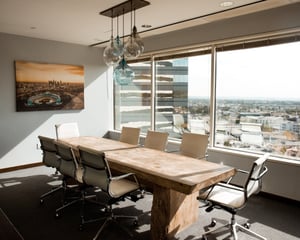Property management has traditionally been viewed as a low-margin business. The Internet of Things (IoT) has offered a unique opportunity for property managers to deliver high-level services. Modern property management has transformed into more than an overhead expense focused on building repairs and operations.
Space-as-a-Service threatens to change traditional CRE models. It will continue to divide opinion. What can’t be debated is that co-working space operators have ushered in new forms of property management through the leveraging of the latest in PropTech. The technology implemented in co-working spaces has become a centerpiece of the Space-as-a-Service model in delivering high-value services to their tenants.
Co-working space tenants expect a certain user experience offered by the Space-as-a-Service model. Transaction costs have been drastically reduced through a pain-free leasing process. You view your pre-built space, lease it, and move in. Who has the time to go through the painful contract negotiations required by the traditional CRE model?
In the Space-as-a-Service context, property management takes center stage. The full spectrum of tenant services is dependent on modern property management. Let’s take a look at a few basic examples of how PropTech delivers new forms of property management.
Intelligent Lighting
Lighting in commercial space greatly impacts tenant comfort and productivity. The WELL Building Standard identifies numerous lighting features that can contribute to good visual acuity in a variety of tasks to avoid eyestrain and to minimize productivity losses and headaches.
 It is noted, for example, that (1) brightness levels can contribute to the perception of spaciousness, as well as to the overall visual appeal of illuminated space, in addition to the impact of detail-oriented tasks such as reading, (2) lighting is one of the main drivers of the circadian system, which can be kept in sync by lighting cues, and (3) non-diffuse, bright indoor lights can result in glare and excessive brightness-contrasts, which can cause visual discomfort, fatigue, visual impairment and even injury. These and other impacts can be reduced using today’s intelligent lighting systems.
It is noted, for example, that (1) brightness levels can contribute to the perception of spaciousness, as well as to the overall visual appeal of illuminated space, in addition to the impact of detail-oriented tasks such as reading, (2) lighting is one of the main drivers of the circadian system, which can be kept in sync by lighting cues, and (3) non-diffuse, bright indoor lights can result in glare and excessive brightness-contrasts, which can cause visual discomfort, fatigue, visual impairment and even injury. These and other impacts can be reduced using today’s intelligent lighting systems.
Modern lighting control systems enable property managers to adapt the lighting within the space to meet the needs of occupants and spaces. Imagine tailoring the lighting environment for individual tenant needs to promote comfort and productivity. Balance brightness and color by room, automate lighting schedules, and track room occupancy all from a mobile device.
Indoor Air Quality Assurance
Other than your home, you spend most of your time at the office. Do you have any idea if the air you’re breathing is polluted? As noted by the Well Building Standard, air pollution is the number one environmental cause of premature mortality.
Amazingly, few buildings have any way to determine whether indoor air pollution exists in the space. Look or ask around. Does your commercial space have any sensors that continually monitor the Indoor Air Quality (IAQ)? Some spaces may measure CO2, but it is rare for office spaces to measure advanced IAQ metrics such as Volatile Organic Compounds (VOCs), combustion byproducts, and airborne Particulate Matter (PM). Unhealthy levels can trigger nausea, headaches, asthma, or respiratory irritation.
 Modern property management provides assurance to tenants of a critical feature of the occupied space by continuously measuring IAQ. Property managers are heroes when they alert tenants before IAQ becomes problematic, rather than responding to an issue after tenants complain. Until IAQ becomes a non-negotiable for tenants, they will not breathe easy.
Modern property management provides assurance to tenants of a critical feature of the occupied space by continuously measuring IAQ. Property managers are heroes when they alert tenants before IAQ becomes problematic, rather than responding to an issue after tenants complain. Until IAQ becomes a non-negotiable for tenants, they will not breathe easy.
Tenant Comfort Using Advanced Controls
HVAC controls are hardly new. They’ve existed for a LONG while as the first thermostat was patented in 1883! The technology for automated room temperature control has been around for 136 years, and not much has changed. Any engineer would be less than impressed at the level of advancement in thermostat design. A thermostat typically integrates a temperature sensor, the readings of which, dictate the control of the HVAC unit dedicated to that HVAC zone.
 Wireless IoT technology enables simple changes to the basic thermostat operation. Instead of a single temperature sensor, multiple temperature sensors can be added within the HVAC zone to better track conditions of the space. CO2 sensors can also be distributed throughout the HVAC zone to drive additional HVAC ventilation when CO2 concentration reaches levels that will impact worker productivity. Building occupants can also impact HVAC operation through their indication of preferences of whether space is too hot or too cold. To an advanced HVAC system, the user preferences would represent just another input into its control loop.
Wireless IoT technology enables simple changes to the basic thermostat operation. Instead of a single temperature sensor, multiple temperature sensors can be added within the HVAC zone to better track conditions of the space. CO2 sensors can also be distributed throughout the HVAC zone to drive additional HVAC ventilation when CO2 concentration reaches levels that will impact worker productivity. Building occupants can also impact HVAC operation through their indication of preferences of whether space is too hot or too cold. To an advanced HVAC system, the user preferences would represent just another input into its control loop.
Tenants would be ever so grateful to property managers that provide this level of control in ensuring tenant comfort.
Conclusion
Property managers can implement these advanced tenant features using retrofits available today. The next generation of tenants will come to expect these features when considering leasing space. Co-working space operators happen to be paving the way with implementing PropTech to deliver advanced tenant services. Don’t ignore their example.

